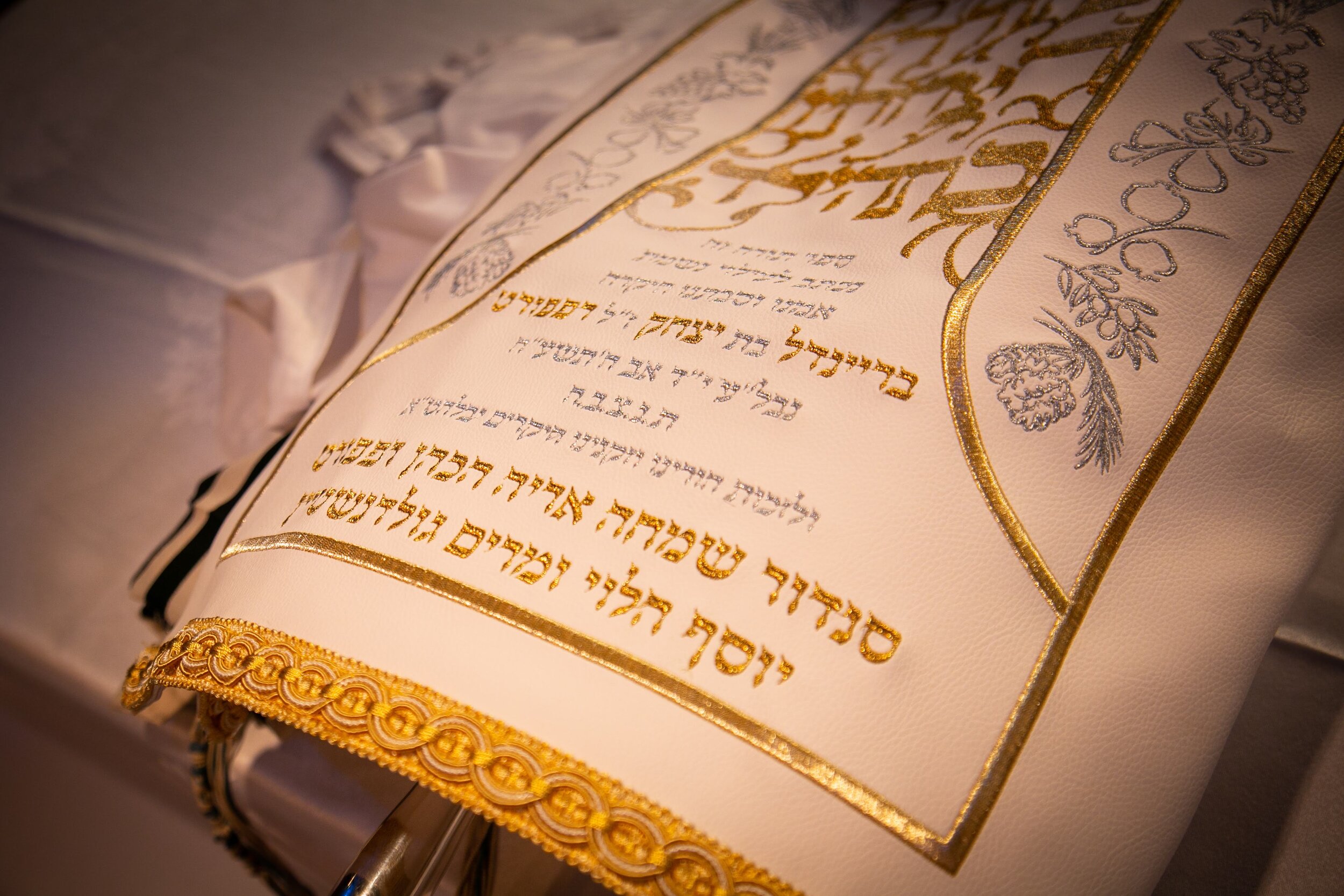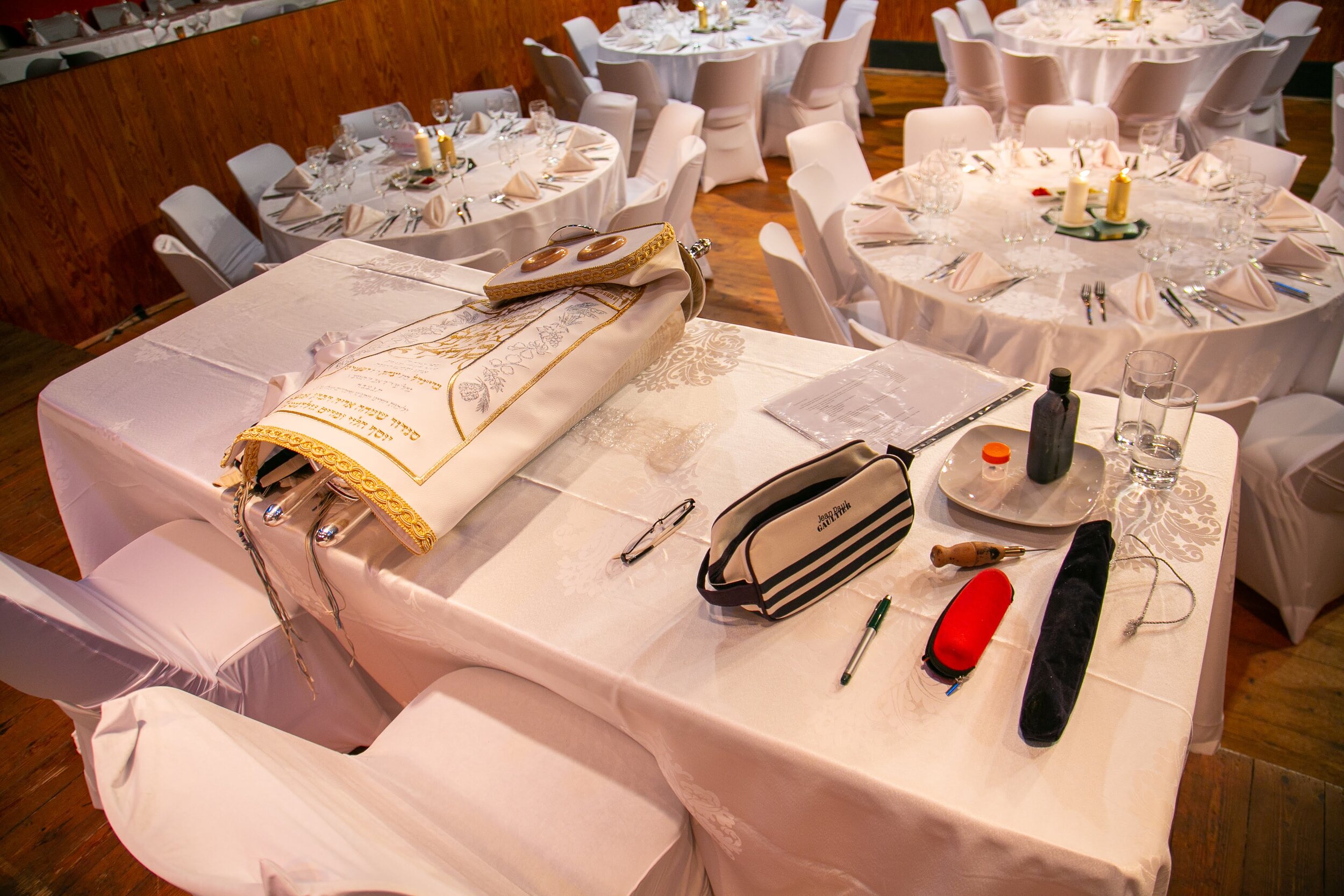How to Prepare for a Hachnassat Sefer Torah
1- Overview
The Rapaport family Torah, dedicated to the Tel HaShomer hospital in Israel.
Ask me for a close-up of this stunning custom Torah mantel.
All those participating will gather to help fill in the final letters of the Torah, dress the Torah and then parade with the new Torah into the shul. It is customary to have anyone holding the Torah to be under a chuppah while marching. The Torahs that are in the shul are brought out of the shul (depending on weather conditions, they can be brought into the street or at least to the entrance of the shul) to ‘greet’ the new Torah as it is being paraded in. It is customary to have live music and singing accompanying the Torah as it makes its way into the shul.
Sometimes, the letters are filled in at the home of the owners if it is not too far from shul or some other place that is close to the shul. Sometimes the letters will be filled in at a room in the shul and after the Torah is ready, it is taken outside, walked around the block with singing and brought back into the main sanctuary of the shul.
After the older Torahs are returned to the ark, the new Torah is placed in the middle. The prayers for putting a Torah away can be said at that time and then have the ark closed.
Finally, there is usually a reception afterwards.
Thus, here are the main things that should be planned in advance:
Instructions to the sofer regarding the number of letters to leave in outline (see below).
Arranging for a band or some kind of musical accompaniment.
Preparing a chuppah.
Appointing someone to be in charge of the order of participants coming to fill in letters (see below).
Asking various people whom the owners wish to honor to dress the Torah at the end, to walk with the Torah to the shul, to bring out the old Torahs to greet the new Torah, to open the ark, to close the ark.
Deciding who will speak while the letters dry (see below).
Arranging for a reception at the end.
2- Preparation
As the sofer nears the end of the writing of the Torah, the owners should instruct the sofer as to how many letters should be left at the end to fill in at the Siyum ceremony. The sofer should leave a few extra to account for last minute participation by guests.
If the number of letters is going to be more than 50, it is wise for the organizers to assign people the order they will be participating in. This can be facilitated by printing out a list of numbered names along with a print-out of the text being filled in.
If the participants are organized, it will take 1-2 minutes to fill in each letter. Often people want to have their picture taken at that time. Thus, if say 50 people are invited to fill in letters, one should figure about an hour and a half.
Depending on other scheduling considerations, it may be wise for the sofer to sew the Breishit panel to the first roller (עץ חיים) in advance of the ceremony to save time. It is a good idea to sew the Dvarim panel to the roller after the letters have been filled in and are completely dry.
3- Filling in Letters
The way I handle the filling in of letters is to, of course, outline the letters in advance. I always write Shem Hashem fully in advance for halachic reasons and Shem Hashem letters should not be counted in the total of letters to be filled in.
As each person (or couple) approaches the sofer, the sofer hands them the quill. The participant holds it and is instructed to appoint the sofer as their agent to fill in a letter in the Torah for them.
In English I tell them to say: I appoint you as my agent to fill in a letter for me in the sefer Torah.
In Hebrew: הנני ממנה אותך שליח לכתוב לי אות בספר התורה.
The sofer then tells them to dip the quill in the ink and hand it back. The sofer then fills in the letter.
It is a good idea to always have the sofer do the actual writing/filling in. This insures that the final letters will blend seamlessly in with the other letters. It also thereby doesn’t distinguish between the participants (men, women, those who are adept with a quill and those who are not) so all participants are treated the same. Further, unless someone has had actual experience writing with a quill, there is a good chance that letters will be rendered pasul by having a non-expert fill them in.
When all letters are filled in, it is a good time for someone (the owners or the rabbi or whomever the owners choose) to speak for about 10 minutes while the letters dry. After that, the sofer will sew the panel to the roller.
4- Hachnassat Sefer Torah
The honor of Hagbah and G’lilah (הגבהה וגלילה) can be given to two people of the owner’s choosing. They will come up and dress the Torah.
At that point, the procession with the Torah can begin. If the Torah is in the shul, it can be taken outside and the chupah held up with someone carrying the Torah underneath. If coming from another location, a spot should be chosen to begin the procession from.
Music, dancing and general glee should ensue as the Torah makes it way to the shul.
Those who are designated to bring the older Torahs out of the ark to ‘greet’ the new Torah should stand at the ready for when the new Torah arrives. Everyone should accompany all the Torahs into the shul. The older Torahs should be replaced first with the new Torah placed last and foremost in the ark. Prayers from the siddur for returning a Torah to the ark can be recited.
Reception follows.
Many thanks to Sofer Shel Bassel for composing this detailed article for My Parochet!
To contact Shel:






